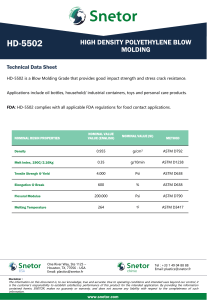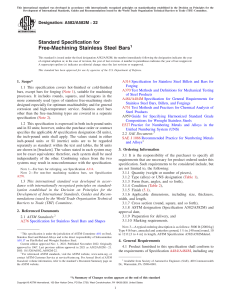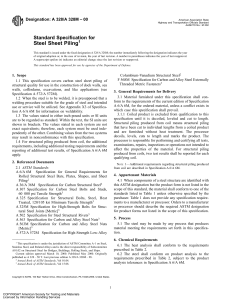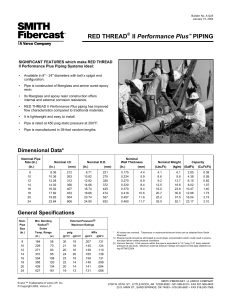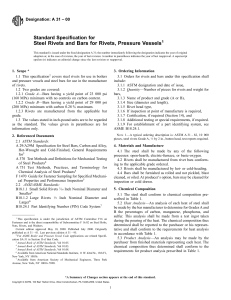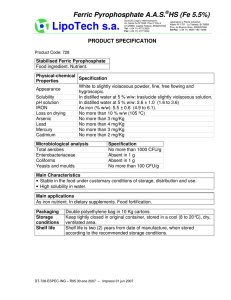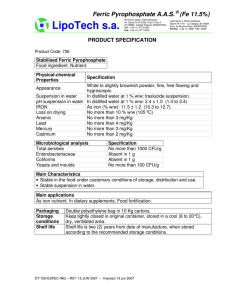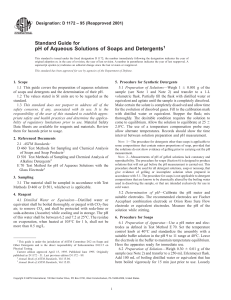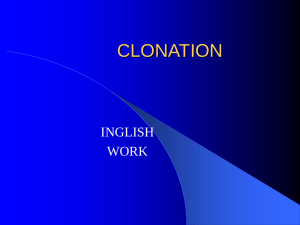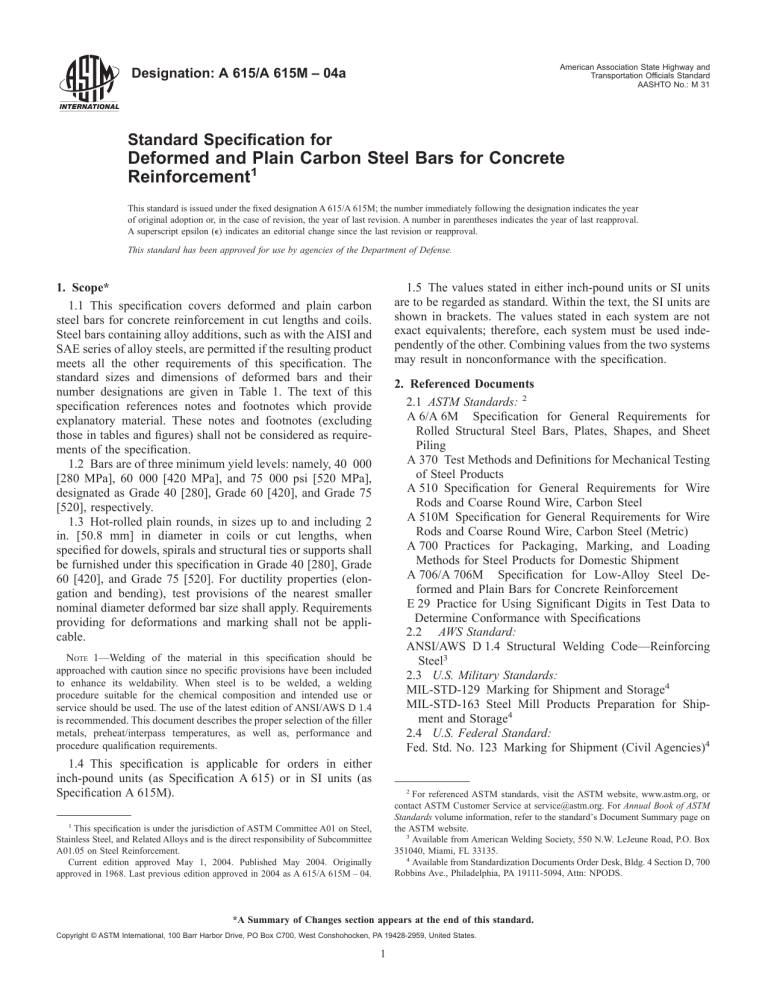
American Association State Highway and Transportation Officials Standard AASHTO No.: M 31 Designation: A 615/A 615M – 04a Standard Specification for Deformed and Plain Carbon Steel Bars for Concrete Reinforcement1 This standard is issued under the fixed designation A 615/A 615M; the number immediately following the designation indicates the year of original adoption or, in the case of revision, the year of last revision. A number in parentheses indicates the year of last reapproval. A superscript epsilon (e) indicates an editorial change since the last revision or reapproval. This standard has been approved for use by agencies of the Department of Defense. 1.5 The values stated in either inch-pound units or SI units are to be regarded as standard. Within the text, the SI units are shown in brackets. The values stated in each system are not exact equivalents; therefore, each system must be used independently of the other. Combining values from the two systems may result in nonconformance with the specification. 1. Scope* 1.1 This specification covers deformed and plain carbon steel bars for concrete reinforcement in cut lengths and coils. Steel bars containing alloy additions, such as with the AISI and SAE series of alloy steels, are permitted if the resulting product meets all the other requirements of this specification. The standard sizes and dimensions of deformed bars and their number designations are given in Table 1. The text of this specification references notes and footnotes which provide explanatory material. These notes and footnotes (excluding those in tables and figures) shall not be considered as requirements of the specification. 1.2 Bars are of three minimum yield levels: namely, 40 000 [280 MPa], 60 000 [420 MPa], and 75 000 psi [520 MPa], designated as Grade 40 [280], Grade 60 [420], and Grade 75 [520], respectively. 1.3 Hot-rolled plain rounds, in sizes up to and including 2 in. [50.8 mm] in diameter in coils or cut lengths, when specified for dowels, spirals and structural ties or supports shall be furnished under this specification in Grade 40 [280], Grade 60 [420], and Grade 75 [520]. For ductility properties (elongation and bending), test provisions of the nearest smaller nominal diameter deformed bar size shall apply. Requirements providing for deformations and marking shall not be applicable. 2. Referenced Documents 2.1 ASTM Standards: 2 A 6/A 6M Specification for General Requirements for Rolled Structural Steel Bars, Plates, Shapes, and Sheet Piling A 370 Test Methods and Definitions for Mechanical Testing of Steel Products A 510 Specification for General Requirements for Wire Rods and Coarse Round Wire, Carbon Steel A 510M Specification for General Requirements for Wire Rods and Coarse Round Wire, Carbon Steel (Metric) A 700 Practices for Packaging, Marking, and Loading Methods for Steel Products for Domestic Shipment A 706/A 706M Specification for Low-Alloy Steel Deformed and Plain Bars for Concrete Reinforcement E 29 Practice for Using Significant Digits in Test Data to Determine Conformance with Specifications 2.2 AWS Standard: ANSI/AWS D 1.4 Structural Welding Code—Reinforcing Steel3 2.3 U.S. Military Standards: MIL-STD-129 Marking for Shipment and Storage4 MIL-STD-163 Steel Mill Products Preparation for Shipment and Storage4 2.4 U.S. Federal Standard: Fed. Std. No. 123 Marking for Shipment (Civil Agencies)4 NOTE 1—Welding of the material in this specification should be approached with caution since no specific provisions have been included to enhance its weldability. When steel is to be welded, a welding procedure suitable for the chemical composition and intended use or service should be used. The use of the latest edition of ANSI/AWS D 1.4 is recommended. This document describes the proper selection of the filler metals, preheat/interpass temperatures, as well as, performance and procedure qualification requirements. 1.4 This specification is applicable for orders in either inch-pound units (as Specification A 615) or in SI units (as Specification A 615M). 2 For referenced ASTM standards, visit the ASTM website, www.astm.org, or contact ASTM Customer Service at [email protected]. For Annual Book of ASTM Standards volume information, refer to the standard’s Document Summary page on the ASTM website. 3 Available from American Welding Society, 550 N.W. LeJeune Road, P.O. Box 351040, Miami, FL 33135. 4 Available from Standardization Documents Order Desk, Bldg. 4 Section D, 700 Robbins Ave., Philadelphia, PA 19111-5094, Attn: NPODS. 1 This specification is under the jurisdiction of ASTM Committee A01 on Steel, Stainless Steel, and Related Alloys and is the direct responsibility of Subcommittee A01.05 on Steel Reinforcement. Current edition approved May 1, 2004. Published May 2004. Originally approved in 1968. Last previous edition approved in 2004 as A 615/A 615M – 04. *A Summary of Changes section appears at the end of this standard. Copyright © ASTM International, 100 Barr Harbor Drive, PO Box C700, West Conshohocken, PA 19428-2959, United States. 1 A 615/A 615M – 04a TABLE 1 Deformed Bar Designation Numbers, Nominal Weights [Masses], Nominal Dimensions, and Deformation Requirements Bar Designation No.A 3 [10] 4 [13] 5 [16] 6 [19] 7 [22] 8 [25] 9 [29] 10 [32] 11 [36] 14 [43] 18 [57] Nominal Weight, lb/ft [Nominal Mass, kg/m] 0.376 0.668 1.043 1.502 2.044 2.670 3.400 4.303 5.313 7.65 13.60 [0.560] [0.994] [1.552] [2.235] [3.042] [3.973] [5.060] [6.404] [7.907] [11.38] [20.24] Nominal DimensionsB Diameter, in. [mm] 0.375 0.500 0.625 0.750 0.875 1.000 1.128 1.270 1.410 1.693 2.257 [9.5] [12.7] [15.9] [19.1] [22.2] [25.4] [28.7] [32.3] [35.8] [43.0] [57.3] Deformation Requirements, in. [mm] Cross-Sectional Area, in.2 [mm2] Perimeter, in. [mm] Maximum Average Spacing 0.11 [71] 0.20 [129] 0.31 [199] 0.44 [284] 0.60 [387] 0.79 [510] 1.00 [645] 1.27 [819] 1.56 [1006] 2.25 [1452] 4.00 [2581] 1.178 [29.9] 1.571 [39.9] 1.963 [49.9] 2.356 [59.8] 2.749 [69.8] 3.142 [79.8] 3.544 [90.0] 3.990 [101.3] 4.430 [112.5] 5.32 [135.1] 7.09 [180.1] 0.262 [6.7] 0.350 [8.9] 0.437 [11.1] 0.525 [13.3] 0.612 [15.5] 0.700 [17.8] 0.790 [20.1] 0.889 [22.6] 0.987 [25.1] 1.185 [30.1] 1.58 [40.1] Minimum Average Height 0.015 0.020 0.028 0.038 0.044 0.050 0.056 0.064 0.071 0.085 0.102 [0.38] [0.51] [0.71] [0.97] [1.12] [1.27] [1.42] [1.63] [1.80] [2.16] [2.59] Maximum Gap (Chord of 12.5 % of Nominal Perimeter) 0.143 0.191 0.239 0.286 0.334 0.383 0.431 0.487 0.540 0.648 0.864 [3.6] [4.9] [6.1] [7.3] [8.5] [9.7] [10.9] [12.4] [13.7] [16.5] [21.9] A Bar numbers are based on the number of eighths of an inch included in the nominal diameter of the bars [bar numbers approximate the number of millimetres of the nominal diameter of the bar]. B The nominal dimensions of a deformed bar are equivalent to those of a plain round bar having the same weight [mass] per foot [metre] as the deformed bar. phosphorus, and sulfur, shall be determined. The phosphorus content thus determined shall not exceed 0.06 %. 6.2 A product check, for phosphorus, made by the purchaser shall not exceed that specified in 6.1 by more than 25 %. 3. Terminology 3.1 Definitions of Terms Specific to This Standard: 3.1.1 deformed bar, n—steel bar with protrusions; a bar that is intended for use as reinforcement in reinforced concrete construction. 3.1.1.1 Discussion—The surface of the bar is provided with lugs or protrusions that inhibit longitudinal movement of the bar relative to the concrete surrounding the bar in such construction. The lugs or protusions conform to the provisions of this specification. 3.1.2 deformations, n—protrusions on a deformed bar. 3.1.3 plain bar, n—steel bar without protrusions. 3.1.4 rib, n—longitudinal protrusion on a deformed bar. 7. Requirements for Deformations 7.1 Deformations shall be spaced along the bar at substantially uniform distances. The deformations on opposite sides of the bar shall be similar in size, shape, and pattern. 7.2 The deformations shall be placed with respect to the axis of the bar so that the included angle is not less than 45°. Where the line of deformations forms an included angle with the axis of the bar from 45 to 70° inclusive, the deformations shall alternately reverse in direction on each side, or those on one side shall be reversed in direction from those on the opposite side. Where the line of deformations is over 70°, a reversal in direction shall not be required. 7.3 The average spacing or distance between deformations on each side of the bar shall not exceed seven tenths of the nominal diameter of the bar. 7.4 The overall length of deformations shall be such that the gap (measured as a chord) between the ends of the deformations on opposite sides of the bar shall not exceed 121⁄2 % of the nominal perimeter of the bar. Where the ends terminate in a longitudinal rib, the width of the longitudinal rib shall be considered the gap. Where more than two longitudinal ribs are involved, the total width of all longitudinal ribs shall not exceed 25 % of the nominal perimeter of the bar; furthermore, the summation of gaps shall not exceed 25 % of the nominal perimeter of the bar. The nominal perimeter of the bar shall be 3.1416 times the nominal diameter. 7.5 The spacing, height, and gap of deformations shall conform to the requirements prescribed in Table 1. 4. Ordering Information 4.1 It shall be the responsibility of the purchaser to specify all requirements that are necessary for material ordered to this specification. Such requirements shall include but are not limited to the following: 4.1.1 Quantity (weight) [mass], 4.1.2 Name of the material (deformed and plain carbon steel bars for concrete reinforcement), 4.1.3 Size, 4.1.4 Cut lengths or coils, 4.1.5 Deformed or plain, 4.1.6 Grade, 4.1.7 Packaging (see Section 21), 4.1.8 ASTM designation and year of issue, and 4.1.9 Certified mill test reports (if desired). (See Section 16.) 5. Material and Manufacture 5.1 The bars shall be rolled from properly identified heats of mold cast or strand cast steel using the electric-furnace, basic-oxygen, or open-hearth process. 8. Measurements of Deformations 8.1 The average spacing of deformations shall be determined by measuring the length of a minimum of 10 spaces and dividing that length by the number of spaces included in the measurement. The measurement shall begin from a point on a deformation at the beginning of the first space to a corresponding point on a deformation after the last included space. 6. Chemical Composition 6.1 An analysis of each heat of steel shall be made by the manufacturer from test samples taken preferably during the pouring of the heats. The percentages of carbon, manganese, 2 A 615/A 615M – 04a 10. Bending Requirements 10.1 The bend-test specimen shall withstand being bent around a pin without cracking on the outside radius of the bent portion. The requirements for degree of bending and sizes of pins are prescribed in Table 3. When material is furnished in coils, the test sample shall be straightened prior to placing it in the bend tester. 10.2 The bend test shall be made on specimens of sufficient length to ensure free bending and with apparatus which provides: 10.2.1 Continuous and uniform application of force throughout the duration of the bending operation. 10.2.2 Unrestricted movement of the specimen at points of contact with the apparatus and bending around a pin free to rotate. 10.2.3 Close wrapping of the specimen around the pin during the bending operation. 10.3 It is permissible to use more severe methods of bend testing, such as placing a specimen across two pins free to rotate and applying the bending force with a fixed pin. When failures occur under more severe methods, retests shall be permitted under the bend-test method prescribed in 10.2. Spacing measurments shall not be made over a bar area containing bar marking symbols involving letters or numbers. 8.2 The average height of deformations shall be determined from measurements made on not less than two typical deformations. Determinations shall be based on three measurements per deformation, one at the center of the overall length and the other two at the quarter points of the overall length. 8.3 Insufficient height, insufficient circumferential coverage, or excessive spacing of deformations shall not constitute cause for rejection unless it has been clearly established by determinations on each lot (Note 2) tested that typical deformation height, gap, or spacing do not conform to the minimum requirements prescribed in Section 7. No rejection shall be made on the basis of measurements if fewer than ten adjacent deformations on each side of the bar are measured. NOTE 2—As used within the intent of 8.3, the term “lot” shall mean all the bars of one bar size and pattern of deformations contained in an individual shipping release or shipping order. 9. Tensile Requirements 9.1 The material, as represented by the test specimens, shall conform to the requirements for tensile properties prescribed in Table 2. 9.2 The yield point or yield strength shall be determined by one of the following methods: 9.2.1 The yield point shall be determined by drop of the beam or halt in the gage of the testing machine. 9.2.2 Where the steel tested does not have a well-defined yield point, the yield strength shall be determined by reading the stress corresponding to the prescribed strain using an autographic diagram method or an extensometer as described in Test Methods and Definitions A 370. The strain shall be 0.5 % of gage length for Grade 40 [280] and Grade 60 [420] and shall be 0.35 % of gage length for Grade 75 [520]. When material is furnished in coils, the test sample shall be straightened prior to placing it in the jaws of the tensile machine. Straightening shall be done carefully to avoid formation of local sharp bends and to minimize cold work. Insufficient straightening prior to attaching the extensometer can result in lower-than-actual yield strength readings. 9.3 The percentage of elongation shall be as prescribed in Table 2. 11. Permissible Variation in Weight [Mass] 11.1 Deformed reinforcing bars shall be evaluated on the basis of nominal weight [mass]. The weight [mass] determined using the measured weight [mass] of the test specimen and rounding in accordance with Practice E 29, shall be at least 94 % of the applicable weight [mass] per unit length prescribed in Table 1. In no case shall overweight [excess mass] of any deformed bar be the cause for rejection. Weight [mass] variation for plain rounds shall be computed on the basis of permissible variation in diameter. For plain bars smaller than 3⁄8 in. [9.5 mm], use Specification A 510 [Specification A 510M]. For larger bars up to and including 2 in. [50.8 mm], use Specification A 6/A 6M. 12. Finish 12.1 The bars shall be free of detrimental surface imperfections. 12.2 Rust, seams, surface irregularities, or mill scale shall not be cause for rejection, provided the weight, dimensions, cross-sectional area, and tensile properties of a hand wire brushed test specimen are not less than the requirements of this specification. 12.3 Surface imperfections or flaws other than those specified in 12.2 shall be considered detrimental when specimens containing such imperfections fail to conform to either tensile TABLE 2 Tensile Requirements Tensile strength, min, psi [MPa] Yield strength, min, psi [MPa] Elongation in 8 in. [203.2 mm], min, %: Bar Designation No. 3 [10] 4, 5 [13, 16] 6 [19] 7, 8 [22, 25] 9, 10, 11 [29, 32, 36] 14, 18 [43, 57] A B Grade 40 [280]A Grade 60 [420] Grade 75 [520]B 60 000 [420] 90 000 [620] 100 000 [690] 40 000 [280] 60 000 [420] 75 000 [520] TABLE 3 Bend Test Requirements Pin Diameter for Bend TestsA Bar Designation No. 11 12 12 ... ... ... 9 9 9 8 7 7 Grade 40 [280] ... ... 7 7 6 6 3, 4, 5 [10, 13, 16] 6 [19] 7, 8 [22, 25] 9, 10, 11 [29, 32, 36] 14, 18 [43, 57] (90°) A Grade 40 [280] bars are furnished only in sizes 3 through 6 [10 through 19]. Grade 75 [520] bars are furnished only in sizes 6 through 18 [19 through 57]. 31⁄2 d B 5d ... ... ... Test bends 180° unless noted otherwise. d = nominal diameter of specimen. B 3 Grade 60 [420] Grade 75 [520] 31⁄2 d 5d 5d 7d 9d ... 5d 5d 7d 9d A 615/A 615M – 04a 15. Test Specimens or bending requirements. Examples include, but are not limited to, laps, seams, scabs, slivers, cooling or casting cracks, and mill or guide marks. 15.1 All mechanical tests shall be conducted in accordance with Test Methods and Definitions A 370 including Annex A9. 15.2 Tension test specimens shall be the full section of the bar as rolled. The unit stress determination shall be based on the nominal bar area. 15.3 The bend-test specimens shall be the full section of the bar as rolled. NOTE 3—Reinforcing bar intended for epoxy coating applications should have surfaces with a minimum of sharp edges to achieve proper cover. Particular attention should be given to bar marks and deformations where coating difficulties are prone to occur. NOTE 4—Deformed bars destined to be mechanically-spliced or buttwelded may require a certain degree of roundness in order for the splices to adequately achieve strength requirements. 16. Test Reports 13. Number of Tests 16.1 When specified in the purchase order, the following information shall be reported on a per heat basis. Report additonal items as requested or desired. 16.1.1 Chemical analysis including carbon, manganese, phosphorus, and sulfur. 16.1.2 Tensile properties. 16.1.3 Bend test. 16.2 A Material Test Report, Certificate of Inspection, or similar document printed from or used in electronic form from an electronic data interchange (EDI) transmission shall be regarded as having the same validity as a counterpart printed in the certifier’s facility. The content of the EDI transmitted document must meet the requirements of the invoked ASTM standard(s) and conform to any EDI agreement between the purchaser and the supplier. Notwithstanding the absence of a signature, the organization submitting the EDI transmission is responsible for the content of the report. 13.1 For bar sizes No. 3 to 11 [10 to 36], inclusive, one tension test and one bend test shall be made of the largest size rolled from each heat. If, however, material from one heat differs by three or more designation numbers, one tension and one bend test shall be made from both the highest and lowest designation number of the deformed bars rolled. 13.2 For bar sizes Nos. 14 and 18 [43 and 57], one tension test and one bend test shall be made of each size rolled from each heat. 13.3 For all bar sizes one set of dimensional property tests including bar weight [mass] and spacing, height, and gap of deformations shall be made of each bar size rolled from each heat. 14. Retests 14.1 If any tensile property of any tension test specimen is less than that specified, and any part of the fracture is outside the middle third of the gage length, as indicated by scribe scratches marked on the specimen before testing, a retest shall be allowed. 14.2 If the results of an original tension specimen fail to meet the specified minimum requirements and are within 2000 psi [14 MPa] of the required tensile strength, within 1000 psi [7 MPa] of the required yield point, or within two percentage units of the required elongation, a retest shall be permitted on two random specimens for each original tension specimen failure from the lot. Both retest specimens shall meet the requirements of this specification. 14.3 If a bend test fails for reasons other than mechanical reasons or flaws in the specimen as described in 14.5 and 14.6, a retest shall be permitted on two random specimens from the same lot. Both retest specimens shall meet the requirements of this specification. The retest shall be performed on test specimens that are at air temperature but not less than 60°F [16°C]. 14.4 If a weight [mass] test fails for reasons other than flaws in the specimen as described in 14.6, a retest shall be permitted on two random specimens from the same lot. Both retest specimens shall meet the requirements of this specification. 14.5 If any test specimen fails because of mechanical reasons such as failure of testing equipment or improper specimen preparation, a replacement specimen shall be permitted. 14.6 If flaws are detected in a test specimen, either before or during the performance of the test, a replacement specimen shall be permitted from the same heat and bar size as the original. NOTE 5—The industry definition invoked here is: EDI is the computer to computer exchange of business information in a standard format such as ANSI ASC X12. 17. Inspection 17.1 The inspector representing the purchaser shall have free entry, at all times while work on the contract of the purchaser is being performed, to all parts of the manufacturer’s works that concern the manufacture of the material ordered. The manufacturer shall afford the inspector all reasonable facilities to satisfy him that the material is being furnished in accordance with this specification. All tests (except product analysis) and inspection, shall be made at the place of manufacture prior to shipment, unless otherwise specified, and shall be so conducted as not to interfere unnecessarily with the operation of the works. 17.2 For Government Procurement Only— Except as otherwise specified in the contract, the contractor is responsible for the performance of all inspection and test requirements specified herein. The contractor shall be permitted to use his own or any other suitable facilities for the performance of the inspection and test requirements specified herein, unless disapproved by the purchaser at the time of purchase. The purchaser shall have the right to perform any of the inspections and tests at the same frequency as set forth in this specification, where such inspections are deemed necessary to ensure that material conforms to prescribed requirements. 4 A 615/A 615M – 04a 20.3.3 Type of Steel—Letter S indicating that the bar was produced to this specification, or for Grade 60 [420] bars only, letters S and W indicating that the bar was produced to meet both Specifications A 615/A 615M and A 706/A 706M. 20.3.4 Minimum Yield Designation—For Grade 60 [420] bars, either the number 60 [4] or a single continuous longitudinal line through at least five spaces offset from the center of the bar side. For Grade 75 [520] bars, either the number 75 [5] or two continuous longitudinal lines through at least five spaces offset each direction from the center of the bar. (No marking designation for Grade 40 [280] bars.) 20.3.5 It shall be permissible to substitute: a metric size bar of Grade 280 for the corresponding inch-pound size bar of Grade 40, a metric size bar of Grade 420 for the corresponding inch-pound size bar of Grade 60, and a metric size bar of Grade 520 for the corresponding inch-pound size bar of Grade 75. 18. Rejection 18.1 Unless otherwise specified, any rejection based on tests made in accordance with 6.2, shall be reported to the manufacturer within five working days from the receipt of samples by the purchaser. 18.2 Material that shows injurious defects subsequent to its acceptance at the manufacturer’s works will be rejected, and the manufacturer shall be notified. 19. Rehearing 19.1 Samples tested in accordance with 6.2 that represent rejected material shall be preserved for two weeks from the date rejection is reported to the manufacturer. In case of dissatisfaction with the results of the tests, the manufacturer shall have the right to make claim for a rehearing within that time. 21. Packaging 21.1 When specified in the purchase order, packaging shall be in accordance with the procedures in Practices A 700. 21.2 For Government Procurement Only— When specified in the contract or order, and for direct procurement by or direct shipment to the U.S. government, material shall be preserved, packaged, and packed in accordance with the requirements of MIL-STD-163. The applicable levels shall be as specified in the contract. Marking for shipment of such material shall be in accordance with Fed. Std. No. 123 for civil agencies and MIL-STD-129 for military agencies. 20. Marking 20.1 When loaded for mill shipment, bars shall be properly separated and tagged with the manufacturer’s heat or test identification number. 20.2 Each producer shall identify the symbols of his marking system. 20.3 All bars produced to this specification, except plain round bars which shall be tagged for grade, shall be identified by a distinguishing set of marks legibly rolled onto the surface of one side of the bar to denote in the following order: 20.3.1 Point of Origin—Letter or symbol established as the producer’s mill designation. 20.3.2 Size Designation—Arabic number corresponding to bar designation number of Table 1. 22. Keywords 22.1 concrete reinforcement; deformations (protrusions); steel bars SUMMARY OF CHANGES Committee A01 has identified the location of the following changes to this standard since A 615/A 615M-04 that may impact the use of this standard. (Approved May 1, 2004) (1) Added 16.2 and Note 5. Committee A01 has identified the location of the following changes to this standard since A 615/A 615M-03a that may impact the use of this standard. (Approved Jan. 1, 2004) (1) Revised the title. (2) Revised 1.1, 4.1.2, and 5.1. (3) Revised 10.3 to eliminate permissive language. 5 A 615/A 615M – 04a Committee A01 has identified the location of the following changes to this standard since A 615/A 615M-03 that may impact the use of this standard. (Approved June 10, 2003). (1) (2) (3) (4) Deleted Note 2. Revised 6.2. Revised 14.5. Revised 14.6. (5) Revised 16.1. (6) Revised 17.2. (7) Revised 19.1. ASTM International takes no position respecting the validity of any patent rights asserted in connection with any item mentioned in this standard. Users of this standard are expressly advised that determination of the validity of any such patent rights, and the risk of infringement of such rights, are entirely their own responsibility. This standard is subject to revision at any time by the responsible technical committee and must be reviewed every five years and if not revised, either reapproved or withdrawn. Your comments are invited either for revision of this standard or for additional standards and should be addressed to ASTM International Headquarters. Your comments will receive careful consideration at a meeting of the responsible technical committee, which you may attend. If you feel that your comments have not received a fair hearing you should make your views known to the ASTM Committee on Standards, at the address shown below. This standard is copyrighted by ASTM International, 100 Barr Harbor Drive, PO Box C700, West Conshohocken, PA 19428-2959, United States. Individual reprints (single or multiple copies) of this standard may be obtained by contacting ASTM at the above address or at 610-832-9585 (phone), 610-832-9555 (fax), or [email protected] (e-mail); or through the ASTM website (www.astm.org). 6
